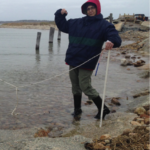Attributed to Aesop is the old parable of the tortoise and the hare. We all know the story and the moral. Slow and steady wins the race. Now lets add to the story a snail and mess with the plot a bit. In the new story both the tortoise and the hare are the winner, and no one thinks the snail will amount to anything-let alone win a race. But eventually the snail does finish. And to truly take the parable over the top all three finish at the same time. Everyone lives happily ever after basking in the glow of their mutual win.
I have probably stretched this analogy as far as it can go.
Scientists know hydrothermal vents from fast spreading ridges like the East Pacific Rise (20 to 40 millimeters per year) and slow spreading ridges like the Mid-Atlantic Ridge (less than 20 millimeters per year). But what about from ultraslow spreading Ridges? Nope, they would be too cold to host large hot vents. But recently some renegade scientists hypothesized that ultraslow ridges could produce a few but large vent fields. A recent expedition by the U.S. and China in the Indian Ocean discovered a vent site that was larger than football field.
So in the end maybe the moral should be a famous quote from Teddy Roosevelt. “Speak softly and carry a big stick; you will go far”






I can’t wait to see the critters! This is an interesting area biogeographically as the Central Indian Ridge displays fauna with similarities to both the Western Pacific back-arc basin vents and the the vents along the mid-atlantic ridge.